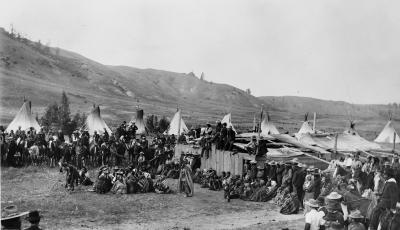Indian Census Records

Natives playing a stick game in front of onlookers on the Colville Reservation, approximately 1900. Indian Census records are another source of information on reservation life in this time period. Source: Spokane City Historic Preservation Office collection.
Here at the Washington State Archives we love our census records, and they are some of the most popular records with the public. The word census is often taken to refer to the federal census, conducted once every ten years as mandated by the Constitution of the United States. There are other censuses in our holdings however, including territorial censuses and even some recorded at the county level during the territorial period.
The Digital Archives also host four censuses of Indian tribes in Washington State. All were performed on the Colville Reservation, which is the home of multiple tribes. The censuses are for the Columbia, Colville, Coeur D’Alene, and Lakes tribes, and were recorded between 1887 and 1914 by various Indian Agents in charge of administering the reservation.
The Indian Censuses have their limitations as sources of information. Though they were supposed to be taken every year on every reservation, actual practice varied. The information collected was sparse, consisting of the person’s name, age, tribe, gender, and marital status. For comparison the Federal Census of 1900 included 28 questions, including occupation, parent’s places of birth, literacy, and whether the person owned his or her own home or rented. The Indian Census did include one unique question: What was the respondent’s “Indian name?” The answers written down by the white Indian Agent were his best guess of how to transcribe what might have been an unfamiliar native language.
Despite their limitations, the censuses are a valuable record of native peoples in a period of challenges and rapid change. On their pages you can find such well-known native leaders as Chief Moses and Chief Barnaby. On the same census page as Barnaby is recorded Alexander Daylight, whose Indian name was Sghel-po, who in 1907 is listed as 109 years of age. If this is accurate he would have been a young boy at the time of Lewis and Clark. (However in the 1903 census he was recorded as youthful 93--so there is some imprecision in the records, as one might expect.) A notation next to Sghel-po notes that this is a Salish word for “blind.”
The Indian censuses can offer clues to not only the lives of specific individuals, but household patterns, demographics, and a shift from native to American-style names in this fascinating period of native history.
-Story by Larry Cebula

